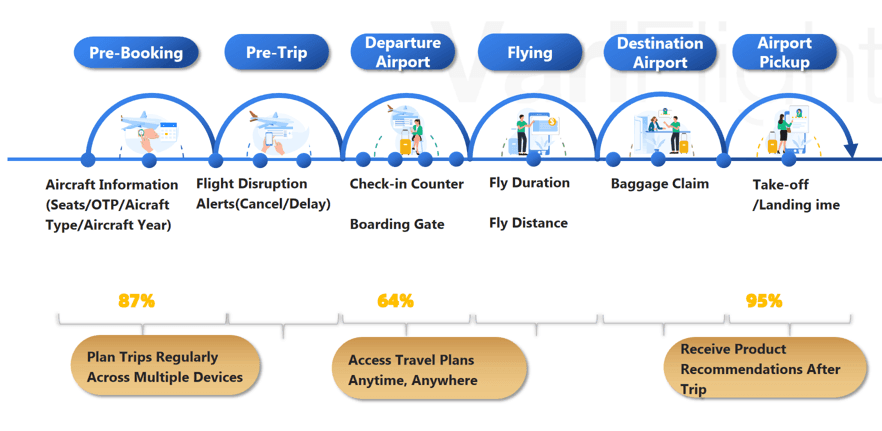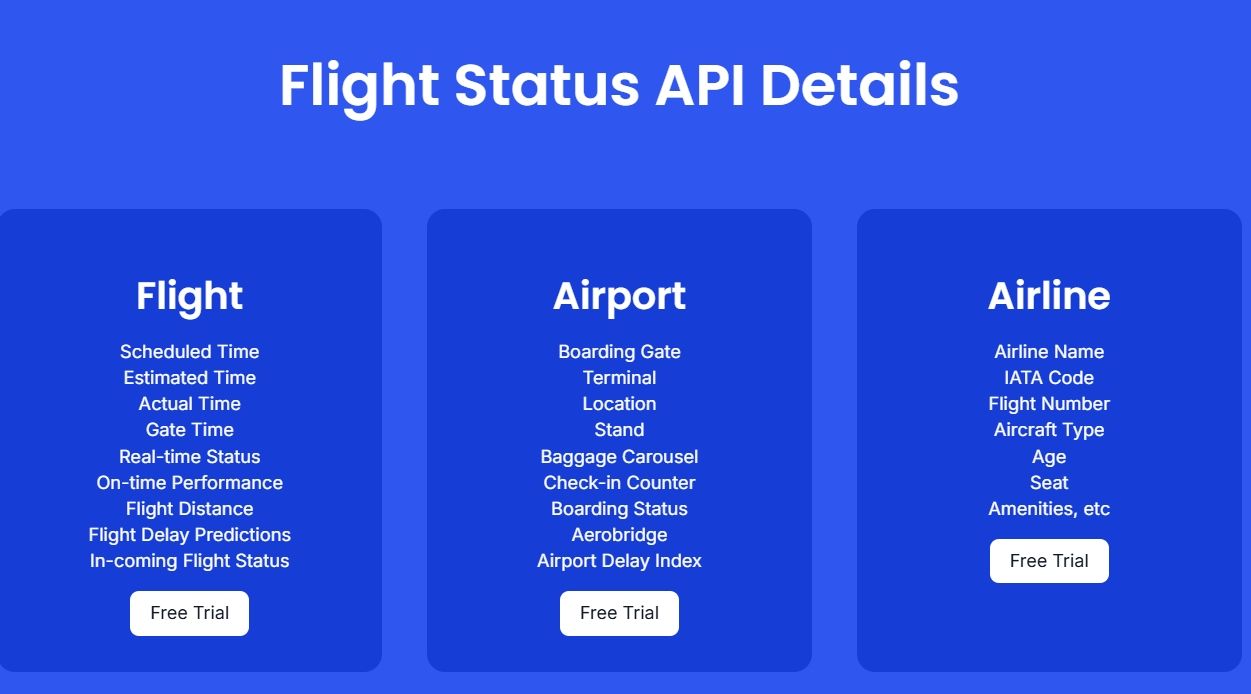Flight Status Data API: Essential Guide for Travel Product Managers
Da
In the fast-paced travel industry, providing travelers with accurate and timely flight information has become a critical differentiator for OTAs, TMCs, and airline partners. Leveraging a flight status data API enables travel companies to offer real-time flight updates, historical insights, and enhanced operational intelligence. This guide walks product managers through the value, integration strategies, and best practices for using a flight status data API, with a focus on DataWorks Flight Status Data API.
What is a Flight Status Data API?
A flight status data API is a digital interface that provides structured access to real-time, historical, and detailed flight information. This includes departure and arrival times, delays, cancellations, gate changes, aircraft details, and other operational data.

Example: Apps like TripIt or Kayak integrate flight status APIs to push notifications about gate changes, delays, and cancellations directly to travelers’ devices, often faster than traditional airline SMS alerts.
Benefit: Reduces manual checks by customer service teams and automates timely communication to passengers.
Protip: Choose APIs that provide unique flight identifiers to avoid ambiguity when multiple flights share the same number and date.
With travel companies increasingly dependent on digital channels, a flight status data API ensures accurate, actionable information that enhances both user experience and operational efficiency.

Why Flight Status APIs Are Critical for Travel Tech
Flight disruptions are inevitable. Without automated systems, travel teams risk slow responses, customer frustration, and increased operational costs. Integrating a flight status API solves these challenges:
Benefit: Automates manual flight status checks, reducing human error and speeding up response times.
Statistic: Modern flight status APIs serve thousands of OTAs and TMC platforms worldwide, demonstrating scalability and reliability.
Protip: Integrate APIs that pull data from multiple sources such as airline operations systems, airport databases, and ADS-B feeds for maximum accuracy.

For product managers, these APIs are not just about tracking flights—they are tools for improving customer satisfaction, reducing support overhead, and enabling predictive operational decisions.
Key Features to Look for in Flight Status Data APIs
When evaluating a flight status data API, product managers should focus on several core capabilities:
Real-time updates: Instant information on schedules, gate changes, delays, and aircraft details.
Historical flight data: Access past flight information to analyze trends, improve customer service, and optimize disruption management.
Global coverage: Ensure APIs cover flights from 1,200+ airlines and 10,000+ airports worldwide.
Example: DataWorks Flight Status Data API tracks 97% of commercial flights globally, offering both real-time and historical data.
Protip: Select providers that offer push notifications instead of polling methods to minimize latency and reduce API call costs.
These features ensure that travel companies can offer a seamless, proactive experience for both travelers and internal operations teams.
Common Use Cases for Flight Status APIs in OTA and TMC Platforms
Integrating a flight status data API unlocks multiple use cases for online travel agencies (OTAs) and travel management companies (TMCs):
Flight Search and Booking Integration
Combining flight search APIs with flight status data APIs allows users to book flights and receive live updates in a single platform. This enhances convenience and builds loyalty.
Proactive Flight Disruption Management
Real-time APIs enable automated alerts for delays, cancellations, and diversions, allowing TMCs to proactively manage traveler itineraries.
Enhanced Customer Experience
Accurate, timely flight information improves traveler confidence and reduces anxiety, particularly for corporate clients with tight schedules.

Example: Travel portals integrating DataWorks API gain access to a broad inventory of global flights, including low-cost carriers and full-service airlines, allowing OTAs to deliver a comprehensive search and status solution.
Statistic: OTAs integrating real-time flight updates report up to 25% fewer customer support inquiries.
By leveraging these use cases, product managers can improve operational efficiency and deliver measurable value to end users.
How to Seamlessly Integrate Flight Status APIs
Smooth integration is crucial for maximizing the benefits of a flight status data API. Product managers should follow structured steps:
Step-by-step:Obtain your API key and review developer documentation.
Test endpoints in a sandbox environment.
Embed flight data into mobile or web applications, ensuring proper mapping to flight identifiers.
Protip: Use caching strategies to optimize performance and control costs, especially for high-volume endpoints.
Example: JSON-based REST APIs from DataWorks simplify integration across multiple frameworks, including JavaScript, Python, and Java, enabling quick deployment in both MVPs and enterprise systems.
Proper integration ensures low latency, high reliability, and a seamless user experience across devices and platforms.
Data Accuracy and LatencySolution: Choose APIs that aggregate multiple data sources, including airline operational systems, ADS-B tracking, and airport feeds.
Coverage Gaps in Regional or Low-Cost FlightsSolution: Confirm provider coverage for secondary airports and low-cost carriers to ensure comprehensive travel data.
Statistic: DataWorks tracks over 170,000 monitored flights daily and 66,000 aircraft via ADS-B, providing high reliability and accuracy for operational decisions.
Protip: Monitor API refresh intervals and set fallback strategies to maintain service continuity during data delays.
Why Product Managers Should Choose Flight Status APIs Wisely
Selecting the right API has a direct impact on traveler satisfaction and operational efficiency:
Impact on Customers: Transparent, real-time flight information reduces anxiety and builds trust.
Influence on Operations: Automates workflows, reduces manual interventions, and enables predictive planning.
Protip: Pilot test APIs with a small user group before enterprise rollout to fine-tune notification triggers, caching policies, and UI displays.
Product managers should treat flight APIs as core operational tools rather than peripheral features, integrating them into both customer-facing and internal workflows.

Flight API Providers Overview
Instead of direct competitor comparisons, focus on evaluating API providers based on features, coverage, and integration support:
Coverage Depth: Domestic vs. international flights; inclusion of low-cost carriers.
Historical Data Availability: Years of past flight data for analytics and predictive modeling.
Integration Support: Developer-friendly documentation, sandbox environments, and robust SDKs.
Example: DataWorks Flight Status Data API offers 97% global commercial flight coverage, real-time updates, and over 10 years of historical data, making it ideal for OTAs, TMCs, and travel tech platforms.

Focusing on these dimensions helps product managers select providers that align with business needs rather than simply chasing brand names.
Content Gap: Historical Flight Data for Business Insights
Historical flight data is often underutilized but provides significant business insights:
Importance: Enables trend analysis, risk assessment, and predictive modeling for travel disruptions.
Example: TMCs use historical delay patterns to negotiate better contracts and proactively manage traveler itineraries.
Protip: Use at least 24 months of historical flight data to forecast seasonal disruption patterns and optimize automated notifications.
Integrating historical data into operational dashboards allows product managers to make data-driven decisions, anticipate traveler needs, and improve overall service quality.

A flight status data API is no longer a “nice-to-have” for travel platforms—it is a foundational tool for improving traveler experience, automating operations, and enabling data-driven decision-making. From real-time flight updates to historical analytics, the right API empowers OTAs, TMCs, and airline partners to reduce operational risk, enhance customer satisfaction, and build scalable, modern travel solutions.
DataWorks Flight Status Data API offers comprehensive coverage, real-time and historical data, and developer-friendly integration, making it a preferred choice for product managers looking to elevate their travel platform’s capabilities.
